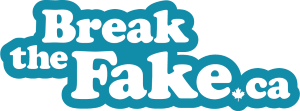Break the Fake Tip #1: Use fact-checking tools
Tip Sheet
- You can use a specific fact-checker website like Snopes.com, or our custom search engine bit.ly/fact-search:
This lets you search all of these fact-checkers at once:
- Snopes.com
- Agence France Presse Canada
- FactCheck.org
- Politifact
- Washington Post Fact Checker
- Associated Press Fact Check
- HoaxEye
- Les Decrypteurs
If you want to use a different fact-checker, make sure it’s signed on to the International Fact-Checking Network’s code of principles (see https://ifcncodeofprinciples.poynter.org/signatories).
- To look at a broader range of sources, do a search for the story with the word “hoax” or “fake” added.
- Because anyone can call themselves a fact-checker, you need to double-check if your search leads to sources you don’t already know are reliable. Check out the Verify the Source tip sheet for more info.
- Remember that just because a fact-checker hasn’t debunked something doesn’t mean it’s true. It can take a while for fact-checkers to verify a story, and not every one will verify every story.
- If no reliable fact-checker has covered it yet, move on to other steps like Find the Source or Check Other Sources.
Make sure to take these steps to double-check before you share anything we see online, every time. Because only you can Break the Fake.

This tip sheet is part of the Break the Fake project. This project has been made possible in part by the Government of Canada.
